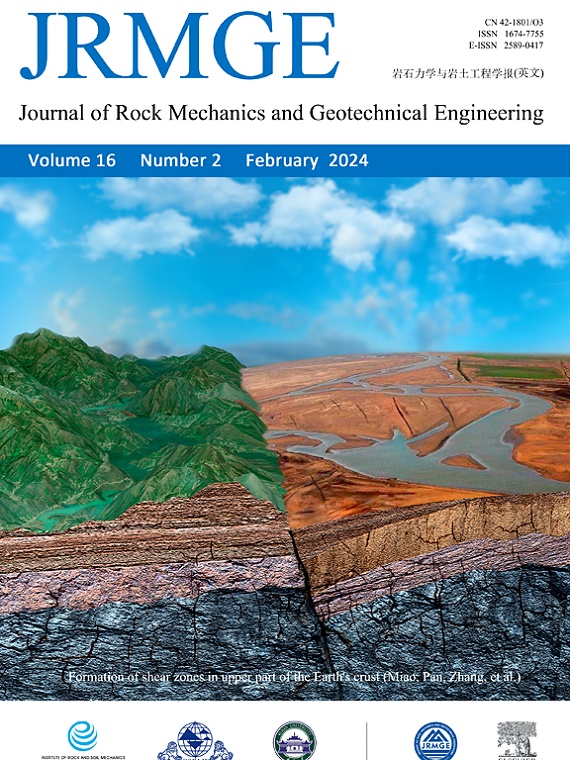求助PDF
{"title":"Potential sliding zone recognition method for the slow-moving landslide based on the Hurst exponent","authors":"Haiqing Yang, Lili Qu, Lichuan Chen, Kanglei Song, Yong Yang, Zhenxing Liang","doi":"10.1016/j.jrmge.2023.08.007","DOIUrl":null,"url":null,"abstract":"The abrupt occurrence of the Zhongbao landslide is totally unexpected, resulting in the destruction of local infrastructure and river blockage. To review the deformation history of the Zhongbao landslide and prevent the threat of secondary disasters, the small baseline subsets (SBAS) technology is applied to process 59 synthetic aperture radar (SAR) images captured from Sentinel-1A satellite. Firstly, the time series deformation of the Zhongbao landslide along the radar line of sight (LOS) direction is calculated by SBAS technology. Then, the projection transformation is conducted to determine the slope displacement. Furthermore, the Hurst exponent of the surface deformation along the two directions is calculated to quantify the hidden deformation development trend and identify the unstable deformation areas. Given the suddenness of the Zhongbao landslide failure, the multi-temporal interferometric synthetic aperture radar (InSAR) technology is the ideal tool to obtain the surface deformation history without any monitoring equipment. The obtained deformation process indicates that the Zhongbao landslide is generally stable with slow creep deformation before failure. Moreover, the Hurst exponent distribution on the landslide surface in different time stages reveals more deformation evolution information of the Zhongbao landslide, with partially unstable areas detected before the failure. Two potential unstable areas after the Zhongbao landslide disaster are revealed by the Hurst exponent distribution and verified by the GNSS monitoring results and deformation mechanism discussion. The method combining SBAS-InSAR and Hurst exponent proposed in this study could help prevent and control secondary landslide disasters. ©2023 Institute of Rock and Soil Mechanics, Chinese Academy of Sciences. Production and hosting by Elsevier B.V. This is an open access article under the CC BY-NC-ND license (http://creativecommons.org/licenses/by-nc-nd/4.0/).","PeriodicalId":54219,"journal":{"name":"Journal of Rock Mechanics and Geotechnical Engineering","volume":"161 2","pages":"0"},"PeriodicalIF":9.4000,"publicationDate":"2023-11-01","publicationTypes":"Journal Article","fieldsOfStudy":null,"isOpenAccess":false,"openAccessPdf":"","citationCount":"0","resultStr":null,"platform":"Semanticscholar","paperid":null,"PeriodicalName":"Journal of Rock Mechanics and Geotechnical Engineering","FirstCategoryId":"1085","ListUrlMain":"https://doi.org/10.1016/j.jrmge.2023.08.007","RegionNum":1,"RegionCategory":"工程技术","ArticlePicture":[],"TitleCN":null,"AbstractTextCN":null,"PMCID":null,"EPubDate":"","PubModel":"","JCR":"Q1","JCRName":"ENGINEERING, GEOLOGICAL","Score":null,"Total":0}
引用次数: 0
引用
批量引用
基于Hurst指数的缓动滑坡潜在滑动带识别方法
中堡滑坡的突然发生是完全出乎意料的,造成了当地基础设施的破坏和河流的堵塞。为了回顾中宝滑坡的变形历史,防范次生灾害的威胁,采用小基线子集(SBAS)技术对Sentinel-1A卫星采集的59幅合成孔径雷达(SAR)图像进行了处理。首先,利用SBAS技术计算了中堡滑坡沿雷达视线方向的时间序列变形;然后进行投影变换,确定边坡位移。通过计算两个方向的地表变形赫斯特指数,量化地表潜在变形发展趋势,识别不稳定变形区。考虑到中堡滑坡破坏的突发性,多时相干涉合成孔径雷达(InSAR)技术是在没有任何监测设备的情况下获取地表变形历史的理想工具。得到的变形过程表明,中堡滑坡在破坏前总体稳定,蠕变缓慢。此外,不同时间阶段滑坡表面的Hurst指数分布揭示了中堡滑坡的更多变形演化信息,在破坏前检测到部分失稳区域。利用赫斯特指数分布揭示了中宝滑坡灾害后的两个潜在失稳区,并通过GNSS监测结果和变形机理讨论进行了验证。本研究提出的SBAS-InSAR与Hurst指数相结合的方法有助于预防和控制次生滑坡灾害。©2023中国科学院岩土力学研究所这是一篇基于CC by-nc-nd许可(http://creativecommons.org/licenses/by-nc-nd/4.0/)的开放获取文章。
本文章由计算机程序翻译,如有差异,请以英文原文为准。


